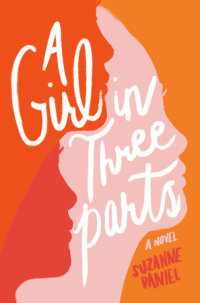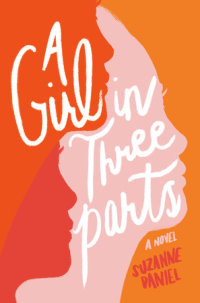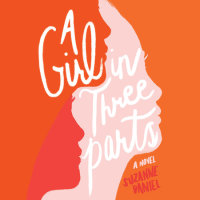A Girl in Three Parts
A story of sisterhood, solidarity, and finding your place in a changing world, A GIRL IN THREE PARTS is an unforgettable coming of age story set against the backdrop of the women's rights movement.
Allegra Elsom is caught in the middle. Some days she's eleven, and others she feels closer to nineteen. Some days she knows too much, and others she feels hopelessly naive. Some days she is split in three, torn between conflicting loyalties to her grandmothers, Matilde and Joy, and her father, Rick--none of whom can stand to be in a room together since the decades-old tragedy that hit their family like a wrecking ball.
Allegra struggles to make peace in her family and navigate the social gauntlet at school while asking bigger questions about her place in the world: What does it mean to be "liberated"? What is it about "becoming a woman" that earns her a slap in the face? What does it mean to do the right thing, when everyone around her defines it differently?
As the feminist movement reshapes her Sydney suburb, Allegra makes her own path--discovering firsthand the incredible ways that women can support each other, and finding strength within herself to stand up to the people she loves.
Readers will not soon forget Suzanne Daniel's poignant debut, or the spirit of sisterhood that sings out from its pages.
An Excerpt fromA Girl in Three Parts
Chapter One
I am Allegra on one side and Ally down the other.
And sometimes I split myself in two.
Patricia O’Brien can keep a Hula-Hoop going around her hips for nineteen minutes, and Scott Perkins can ride his bike the entire length of Blair Street with both hands on his knees and a kitten around his neck. And me . . . well . . . my trick is: I can split myself in two. It’s not really a trick; it’s more my inside-out secret, something I have to do because of Joy and Matilde. They are my grandmothers, and I love them both and they totally love me, in very different ways.
But they can’t stand each other, not even for the count of one-apple-pie.
Sister Josepha has chosen me to read the prayer at today’s outdoor assembly, our first now that I’ve moved up to sixth grade after the long summer break. She said she was impressed by my papier-mâché of the Angel Gabriel appearing to the Virgin Mary. Then Kimberly from the Popular Group announced to the class, “It’s not even dry!” but here I am, Sister nods and I know exactly what I have to do: deliver the prayer in equal parts to Joy and Matilde.
There’s Joy—radiant—in a mauve sun hat on the lunch benches under the mulberry tree. She’s sitting next to Patricia O’Brien’s mother, who all the sixth-grade boys think is a good sort especially after she showed off her own skills with Patricia’s Hula-Hoop after Patricia arrived new to school last term. They’re laughing about something hilarious, and Joy’s bright face is dancing in tune with Mrs. O’Brien’s multicolored bangles. But the moment I step forward, Joy’s head stops dead still and her eyes fasten, fully fixed on me. The prayer is asking the Dear Lord to give us the strength during Lent to resist what we’ve offered up. And as saintly as Joy looks now, and as prayerful as she may appear, I know she’s probably thinking: Why give up anything, sweetie, when indulgence is so delicious!
Making Joy focused makes me feel alive.
Matilde is all in fawn at her post near the girls’ toilets, alone. She doesn’t cook her Hungarian meatballs on meatless Fridays, but I know that she’s not a fan of Lent, or of God, for that matter. I think she’s pretty mad at him after what happened to her family back during the war. And then there’s all the things “that man” did. I don’t know who “that man” was exactly, or what he did exactly. I just try to piece together what I can when Matilde’s sister visits the first Wednesday of each month, and I cup my ear against the closed door and catch every fourth word when they mix their mother tongue with English. It’s like a jigsaw puzzle I’ve been putting together for as long as I remember. Aunt Helena always leaves looking triumphant, while Matilde looks exhausted and her lips are kind of pale and pinched.
But this morning in the playground, as I deliver the prayer in Matilde’s direction, I see her lips relax and form a sort of proud shape and she looks almost S-E-R-E-N-E. . . . That was a word on my spelling list last week.
Making Matilde exhale makes me feel calm.
So at eleven and a half this is what I know so far: Adults can love you and care for you in different ways that work for them and work for you. It’s kind of like the soft drinks delivered to the Lucky Listers across the road, all different flavors but all really good. But while the adults love you in these different ways, sometimes they seem to loathe the differences in each other. They can be mad with their own grown-up children, and those grown-up children can be mad with their parents, even though they’re old. But all of them can keep on loving you, as long as you’re just a kid, and you pretend not to notice this badness of feeling and you don’t tell any of them straight out that you love the others very much, or even that you love all of them the same. But sometimes I really wish it were different.
I live in Number 23 with Matilde. Rick lives there too—sort of—he’s in the flat above the garage. Rick’s tall and strong and he’s my dad, which you would think would make Matilde notice him, but she’s got a blind spot when it comes to Rick. She knows he’s there because she plates up his dinner and irons his board shorts and ticks her tongue when she hears the horse races coming from the radio inside his flat. Luckily Rick doesn’t say that much, so I can usually ignore Matilde ignoring Rick. Occasionally, though, when I see that awful sad look on Rick’s face, more banished-bold-boy than dad-sized man, I feel a tightness in the part of my heart that lives behind my throat. And on those days, I am split in three.
Number 23 is sturdy and clean, dark brick on the outside and dark wood inside. Things are always in order because of Matilde, who spends hours dusting, polishing and mending; she never rests, just a couple of sips of black tea downed at the kitchen sink and she keeps going. My uniform is neatly pressed, hanging on the outside of my wardrobe every evening above my shined shoes and packed bag. My fingernails are cleaned every night, and cut once a week and my hair is washed and inspected for nits on Sunday afternoons.
There’s no getting out of piano practice with Matilde; she can call a wrong note from the laundry and the wrong tempo while weeding the garden. She hears my spelling words on weeknights and gives me an additional list of her own. In third grade, I was the only kid in the whole school who could spell D-I-A-R-R-H-E-A and that earned me the pick from Sister Josepha’s holy card drawer. As I was choosing between Angels Point the Way and Mater Dolorosa, Kimberly from the Popular Group announced: “Let’s call Allegra DIARRHEA PANTS!” She’s the meanest girl in our class and definitely disrupts my digestion.
After school it’s Matilde’s cooking that steadies my stomach and warms my world. When I get to the lane, I know instantly whether it’s chicken paprikash, pork sausage or goulash soup for dinner. It’s all made from scratch, using the choicest pickings from Matilde’s garden and served with hot cheese bread. It’s nothing like the chops, peas and instant mashed potatoes the Lucky Listers have most nights, but to me it smells like home and tastes like love.
Matilde’s garden is as practical as she is. There are raised vegetable beds with tomatoes, zucchinis, onions and beets, in fact just about every vegetable I can spell and some I can’t. Beyond the six raised beds is a chook pen with three laying hens, which Rick and I have named Scrambled, Boiled and Omelette. He said it’s best not to tell Matilde—she’d think naming the chooks is complete nonsense. I sometimes imagine that if the Holocaust came to North Bondi, I could hide in the shed under the bench between the compost bin and the tools, and I could survive for years on the fresh food in Matilde’s garden.
Through the brown gate in our side fence and along the path is Number 25. This is where Joy lives, and there’s nothing remotely edible in her garden. It’s been created, she says, to enliven the senses. On Joy’s side life is in full bloom. Color and scent cocoon me, and my heart always skips to a little trot. Orange and pink bougainvilleas, purple paper daisies, climbing jasmine and our favorite, the fuchsias: Joy is teaching me their names and how to care for each one. Painted rocks border a water-lily pond that is home to a penny tortoise called Simone de Beauvoir. Some nights when Joy gets home from Liberty Club, she discusses issues with Simone de Beauvoir; I can hear her from my bedroom. It’s kind of weird but mostly a funny sort of interesting. Wind chimes hang from all of Joy’s frangipani trees that run along our fence line so that on a breezy afternoon we can hear their tunes from Number 23. It gives me little air bubbles down the part of my heart that runs along my spine. But if Matilde hears the chimes from next door, she ticks her tongue and closes all the windows.
000
After a sweltering first week of the first term back at school, it’s Sunday, and I’m looking for Joy. I find her in the glasshouse dusting her emotions. Joy, you see, has kept every tear she’s ever shed throughout her adult life, all in colored bottles, lined up, dated and labeled. Whenever she feels inclined, we go through the bottles, and she tells me the stories behind each one.
My favorite is elation, dated 18 September 1962—the very day I was born. Joy gives it a good dust and a little kiss. There’s forced choice, dated 25 November 1943. That bottle was filled just after she told the persistent American officer with the navy-blue eyes that she had a responsible Australian fiancé her parents particularly liked who would be returning to Sydney very soon. There’s sorrow, dated 2 January 1954, the day her father, my great-grandfather Albert, passed away. This stands beside one I don’t really understand called self-actualization, which is a purple glass bottle dated 8 March 1973, three-quarters filled after she went to her first Liberty Club meeting.



